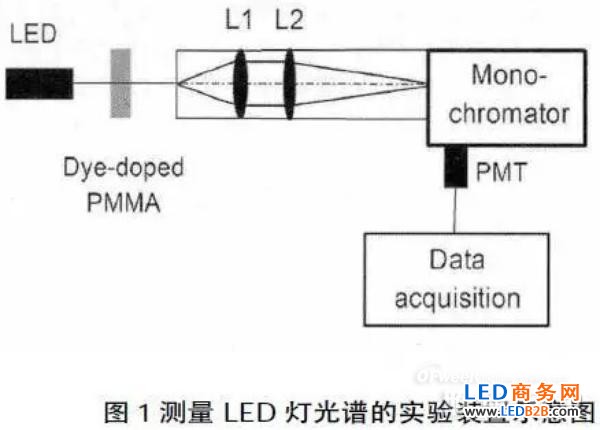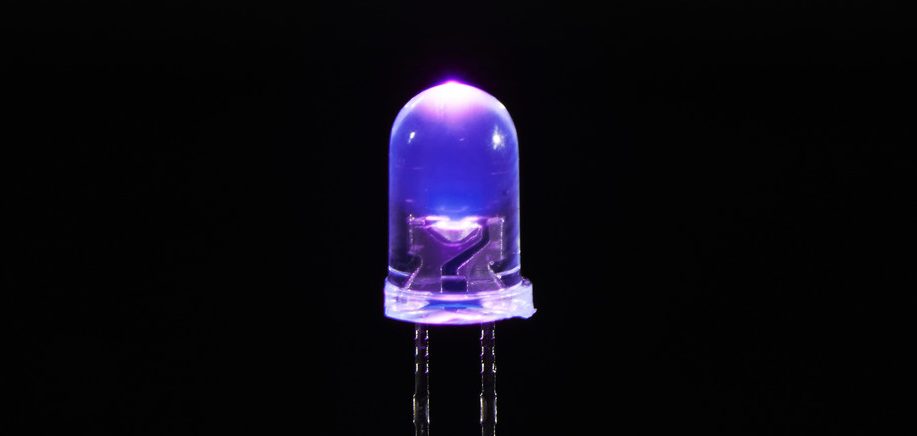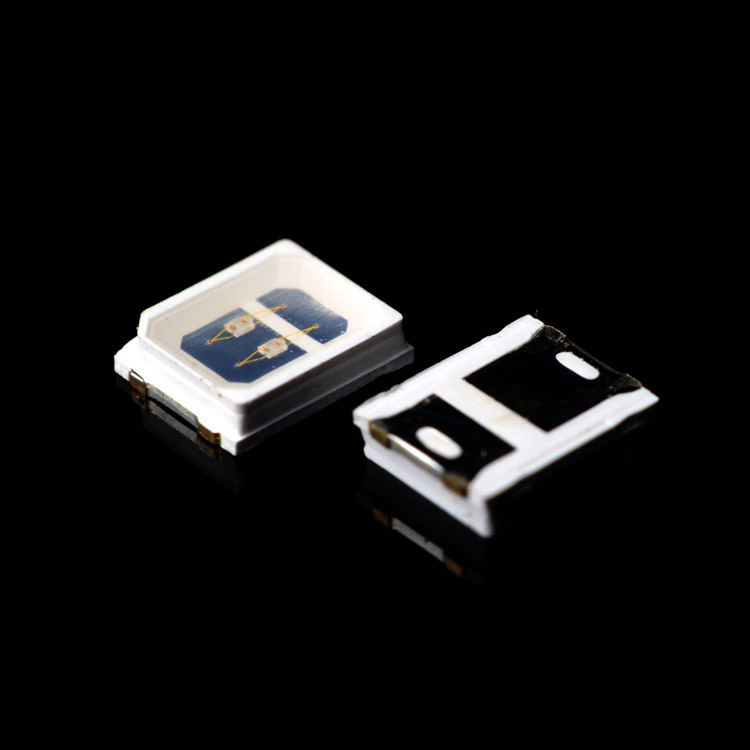At present, there are generally three methods for manufacturing white LEDs . The first is a two-primary white LED, which uses a blue light emitted by an InGaN led chip to excite a Ce:YAG phosphor , which is then mixed by the blue light of the LED and the fluorescence produced by the Ce:YAG phosphor to obtain white light. The technology is relatively mature and low in cost, so it is widely used. The second type is a synthetic white LED based on three primary color phosphor conversion, which uses ultraviolet LED light to excite red, green and blue phosphors to achieve white light output. Due to the low efficiency of the UV LED and the difficulty in matching the phosphor, it is less applicable. The third type is a multi-chip white LED, which mixes the light of three colors of red, green and blue LEDs to obtain a white light output. This technology has higher control requirements on the chip and increases the technical cost, so it is currently less used.
Studies have shown that using blue light cut-off filters to filter out blue light can reduce the damage of blue light to the human eye. The current commercially available blue-ray protective glasses and shields are blue-light filters based on coating technology to filter out most of the blue light. The technique is to reflect the blue portion of the light source, so that the total brightness of the light source is attenuated to some extent, and the energy of the basket light is wasted.
In fact, another method can be used, which can attenuate most of the blue light in the light source, and convert the blue light into green light and yellow light that are not harmful to the human eye, so that the total brightness of the light source is less attenuated. This technique uses a suitable fluorescent dye to specifically absorb the blue light in the led lamp and emit green and yellow light by the fluorescent radiation of the dye molecule to supplement the loss of the brightness of the light source caused by the absorption of the blue light.
In this paper, the dye-doped polymer is used to absorb the blue light in the LED lamp to reduce the blue light hazard of the LED lamp, and the spectrum and chromaticity of the light source before and after absorption are compared and evaluated.
1. Sample synthesis and spectrum measuring device
The synthesis method of the dye-doped polymer used in this study is briefly described as follows: methyl methacrylate, methyl acrylate, ethyl acrylate, dibutyl phthalate, azobisisobutyronitrile, n-butyl sulphide The alcohol reagent is mixed in an appropriate ratio, pre-polymerized at a temperature of 80 ° C for about 15 minutes, cooled and mixed into the prepared dye solution, and then further polymerized at 55 ° C, 80 ° C and 100 ° C for a total of 17 hours to obtain a dye. Doped polymethyl methacrylate (PMMA) polymer. The polymer was mechanically cut into discs of suitable thickness and the ends were then ground and polished for experimental measurements. The wafer has a diameter of 10 mm, a thickness of 4 mm and 8 mm, respectively, and a doping concentration of the dye in the polymer of 0.01 mg/g.

Figure 1 is a schematic diagram of an experimental apparatus for measuring the spectrum of an LED lamp before and after absorption. The LED Light Source is a 3W power projection lamp purchased from the market. The projected parallel light is passed through the dye-doped PMMA sheet and then the light-receiving system composed of L1 and L2 lenses is imaged at the entrance slit of the monochromator. . The model of the monochromator is Omni λ3005 (Zhuoli Hanguang), its focal length is 30cm, the wavelength scanning range is 300-900nm, and the photomultiplier tube is CR114 type. In order to eliminate the spectral overlap of the different diffraction orders, a filter is added at the exit slit, the choice of which is automatically controlled by the wavelength scanning software. When scanning the spectrum, the signal of the photomultiplier tube is recorded by A/D conversion and further processed. The wavelength scanning control and spectral data storage of the monochromator are performed by a computer.
2, spectral measurement
In order to evaluate whether the light color of the led light before and after the secondary spectral conversion meets the lighting requirements, the CIE1931 chromaticity coordinate system of the International Lighting Association can be used. In order to obtain accurate measurements, it is necessary to calibrate the wavelength and spectral response of the spectrometer. The experiment first calibrated the wavelength of the monochromator with a sodium light. Then, the standard light source A specified by the International Lighting Association, that is, a tungsten halogen lamp with a color temperature of 2856K, was used to calibrate the spectral response of the monochromator. The spectral response curve of the monochromator used in the experiment can be obtained by comparing the spectrum of the lamp measured by the monochromator with its standard spectrum. In all subsequent measurements, the spectra used to calculate the chromaticity coordinates have been calibrated for this response curve.
The experiment first measured the spectrum of a commercially available LED lamp in the visible range. In the blue light range of 420-480nm, the led lamp has a high intensity. If the blue light is not optimized, long-term application of the LED light for illumination may cause potential and long-term harm to the human eye.
Since the center wavelength of the blue light in the LED lamp is located at 450 nm, if a suitable dye is selected to effectively absorb the blue light of the band, the blue light hazard of the LED lamp can be better reduced. To this end, we chose to use coumarin 540 (C540) dye to dope in PMMA to obtain C540-doped PMMA polymer and use it to adjust and optimize the spectrum of LED Lamps . The absorption center of the C540 is located at 450 nm, which matches the blue light of the LED lamp. The center of the dye emission peak is at 520 nm and its Stokes shift reaches 70 nm.
Then, a dye-doped polymer sheet having a thickness of 4 mm and 8 mm of C540 dye doping concentration of 0.01 mg/g and a commercially available green PMMA plate having a thickness of 3 mm were respectively used to absorb blue light in the LED lamp. Conversion. The fluorescent substance doped in this commercially available green PMMA plate having a thickness of 3 mm is a 3GF oil-based fluorescent dye with a high doping concentration. Since the absorption band and emission spectrum are similar to C540, it is compared here as a set of comparative samples with C540 dye-doped polymer sheets.
From the visual comparison of the above measurement results, it can be seen that the commercially available white LED light source has a high blue component, and if the LED lamp is used for indoor illumination and display backlight, it may cause potential harm to the human eye. After filtering with a 4 mm thick C540 dye doped polymer sheet, the blue light was attenuated by about 1/3. Increasing its thickness further reduces the proportion of blue light. At 8 mm thick, the blue light remains only about 1/3 of the original intensity. Due to the higher concentration of the oily fluorescent dye in the commercially available 3 mm thick green PMMA plate, all of the blue light in the LED lamp was absorbed. The intensity of green light in the spectrum obtained in the above three cases is slightly higher than the original green light of the LED, and is a contribution from the fluorescence emitted by the C540 dye or the green oil fluorescent dye.
We are UV LED manufacturer from China.
China 365Nm LED supplie
We will do the High temperature resistance testing and 10 hours ageing treatment before the product out off the factory, which can ensure the stability of each product.
Our LED products have 5 year warranty. We are the best supplier for your light-emitting diode.


We supply variety of 365nm LED products. Including Through-hole 365nm LED, SMD 365nm LED and high-power 365nm LED. We can also produce 365nm LED according to your requirement.
For the Through-hole Light Emitting Diode 365nm LED,
we can customize the shape, the lighting angle, the number of emitting source, the flat pin LED and braided LED. Such as: 5mm purple 365nm LED, 5mm purple 365nm LED, 5mm purple 370nm LED, 5mm purple 375nm LED, 5mm purple 380nm LED, 5mm purple 385nm LED, 5mm purple 390nm LED, 5mm purple 395nm LED, 5mm purple 400nm LED 5mm round head Purple LED. 3mm Purple 365nm LED, 3mm Purple 365nm LED, 3mm Purple 370nm LED, 3mm Purple 375nm led, 3mm Purple 380nm led, 3mm Purple 385nm LED, 3mm Purple 390nm LED, 3mm Purple 395nm LED, 3mm Purple 400Nm LED 3mm Round Purple LED ect.
There are many other shapes for your choose. Customized purple LED are available
For the SMD LED 365nm LED,
we can supply dual-chip purple LED, three-chip purple LED, multi-chip purple LED, high voltage LED, flashing purple LED and variety of size SMD LED. For instance: 3528 SMD purple 365nm LED, 3528 SMD purple 365nm LED, 3528 SMD purple 370nm LED, 3528 SMD purple 375nm led, 3528SMD purple 380nm led, 3528 SMD purple 385nm LED, 3528 SMD purple 390nm LED, 3528 SMD purple 395nm LED, 3528 SMD purple 400nm LED, 3528 SMD purple LED . 2835 SMD Purple 365nm LED, 2835 SMD Purple 370nm LED, 2835 SMD Purple 375nm LED, 2835SMD Purple 380nm LED, 2835SMD Purple 385nm LED, 2835SMD Purple 390nm LED, 2835SMD Purple 395nm LED, 2835SMD Purple 400nm LED.
There are also have many other shapes to choose, like the 5050 SMD Purple LED, the 5730 SMD Purple LED ect. You can choose any one of them for your requirement.
365nm led is a Ultraviolet LED. Common purple LEDs are like: Ultraviolet 365nm LED, ultraviolet 370nm LED, ultraviolet 375nm led, ultraviolet 380nm led, ultraviolet 385nm LED, ultraviolet 390nm LED, ultraviolet 395nm LED, ultraviolet 400nm LED and so on.

365nm LED
365Nm LED,365Nm UV LED,365Nm High Power UV LED,365Nm LED For Press
Shenzhen Best LED Opto-electronic Co.,Ltd , https://www.bestsmd.com